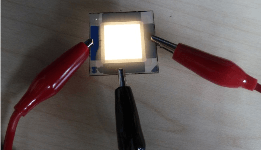OLED prototype sets new efficiency record
on

Researchers at Osram have set a new efficiency record with a lab prototype OLED. The lab device achieved a luminous efficiency of 87 lm/W, significantly higher than the current peak level. What’s more, according to Osram the laboratory prototype is very close to being ready for mass production, paving the way for highly energy efficient OLED products with considerably higher brightness.
The organic material used for the OLED has already been tested in pilot manufacturing and yields lifetimes suitable for practical products. The OLED prototype was fabricated using pure thin-film technology. A special injection electrode in the light-emitting layer was used to distribute current evenly over the active surface, providing uniform light intensity from every angle, and the aesthetic quality of the device is not marred by visible electrode structures.
This marks a major step on the way to Osram’s goal of developing mass-market OLEDs. The luminous efficiency of the lab prototype exceeds the best previous value by 40%, which puts it close to the efficiency of fluorescent lamps. Furthermore, this performance was achieved obtained under typical application conditions using an integrating sphere, which means without using special lenses to optimise the measurement results. The measurements were made at a brightness of 1,000 cd/m2 and a colour temperature of approximately 4,000 K. Another bit of good news from the research team is that the prototype achieved nearly 75 lm/W at a brightness of 5,000 cd/m2.
Image: Osram


Discussion (0 comments)